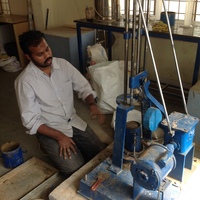- Aspiring to grow as a Geotechnical Engg subject matter expertedit
The design of the pavement layers to be laid over sub grade soil starts off with the estimation of sub grade strength and the volume of traffic to be carried. Design of the various pavement layers are very much dependent on the strength... more
The design of the pavement layers to be laid over sub grade soil starts off with the estimation of sub grade strength and the volume of traffic to be carried. Design of the various pavement layers are very much dependent on the strength of the sub grade soil over which they are going to be laid. Sub grade strength is mostly expressed in terms of CBR (California Bearing Ratio). Weaker sub grade essentially requires thicker layers whereas stronger sub grade goes well with thinner pavement layers. The sub grade is always subjected to change in saturation level due to precipitation, capillary action, flood or abrupt rise or subside of water table. Change in moisture level in sub grade ca uses change in the sub grade strength. And it becomes quite essential for an engineer to understand the exact nature of dependence of subgrade strength on moisture variation. An understanding of the dependence of the CBR strength of local soils on water content will contribute towards better design and maintenance practices. Normally CBR test is an easy and well adopted method conducted on soil samples to measure the strength of sub grade. However, many other tests are also considered for assessing the sub grade strength.
The strength of soil, used for sub grade may vary largely on the amount of saturation in it, i.e. amount of water exposed to the soil. Hence, in this study an attempt has been made to vary the degree of soaking and hence the saturation level in various types of soils and study the engineering properties of soils including CBR at different saturation levels.
It is observed that for coarse grained soil, worst engineering properties are observed after three days of soaking and for fine grained soils, the same is found at the end of four days.
The strength of soil, used for sub grade may vary largely on the amount of saturation in it, i.e. amount of water exposed to the soil. Hence, in this study an attempt has been made to vary the degree of soaking and hence the saturation level in various types of soils and study the engineering properties of soils including CBR at different saturation levels.
It is observed that for coarse grained soil, worst engineering properties are observed after three days of soaking and for fine grained soils, the same is found at the end of four days.
Research Interests:
Strengthening structures via external bonding of advanced fibre reinforced polymer (FRP) composite is becoming very popular worldwide during the past decade because it provides a more economical and technically superior alternative to the... more
Strengthening structures via external bonding of advanced fibre reinforced polymer (FRP) composite is becoming very popular worldwide during the past decade because it provides a more economical and technically superior alternative to the traditional techniques in many situations as it offers high strength, low weight, corrosion resistance, high fatigue resistance, easy and rapid installation and minimal change in structural geometry. Although many in-situ RC beams are continuous in construction, there has been very limited research work in the area of FRP strengthening of continuous beams. In the present study an experimental investigation is carried out to study the behavior of continuous RC beams under static loading. The beams are strengthened with externally bonded glass fibre reinforced polymer (GFRP) sheets. Different scheme of strengthening have been employed. The program consists of fourteen continuous (two-span) beams with overall dimensions equal to (150×200×2300) mm. The beams are grouped into two series labeled S1 and S2 and each series have different percentage of steel reinforcement. One beam from each series (S1 and S2) was not strengthened and was considered as a control beam, whereas all other beams from both the series were strengthened in various patterns with externally bonded GFRP sheets. The present study examines the responses of RC continuous beams, in terms of failure modes, enhancement of load capacity and load deflection analysis. The results indicate that the flexural strength of RC beams can be significantly increased by gluing GFRP sheets to the tension face. In addition, the epoxy bonded sheets improved the cracking behaviour of the beams by delaying the formation of visible cracks and reducing crack widths at higher load levels. The experimental results were validated by using finite element method.
Keywords: continuous beam; flexural strengthening; GFRP; premature failure; debonding failure.
Keywords: continuous beam; flexural strengthening; GFRP; premature failure; debonding failure.
